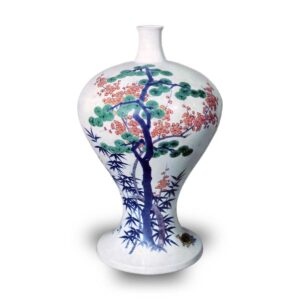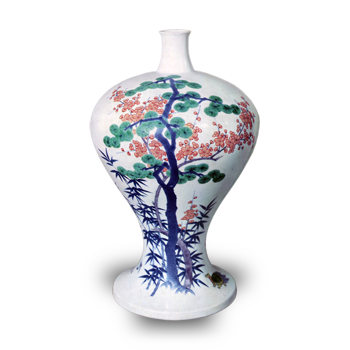
Iro-nabeshima vase with pine, bamboo, plum, and tachibana motifs
Height 30.6cm, mouth diameter 3.5cm, body diameter 18.6cm, bottom diameter 14.5cm
Important Cultural Property
This is a rare example of an inlaid Nabeshima sake bottle. It is truly elegant in both form and design, and it is no wonder that it is considered to be the most famous of all the Nabeshima vases in overglaze enamels.
The basic form of sake jars in Japan has been handed down since the Heian period (794-1185), and this jar is a rare example of a jar from the mid-Edo period that adheres to the old style. This vase is a rare example of a mid-Edo period vase that adheres to the old style, and judging from the completed underglaze blue and overglaze enamels, it was probably made around the Genroku period. It was made in imitation of an old style vase and specially adjusted. Since it is a sake bottle, it was probably dedicated to an appropriate shrine or used by the lord of a feudal domain as an item of furniture for an auspicious occasion.
The body, which shows a flowing curve from the rounded shoulder to the bottom, is graceful and elegant with a neatly raised neck.
On the white porcelain body, which is unique to the Okawachi Kiln, pine, bamboo, and plum blossoms are on one side, and tachibana and chrysanthemums are on the other side, with cranes and turtles on the left and right. The underglaze blue and line painting, as well as overglaze painting in red, yellow, light green, light purple, and other colors, are brightly and gorgeously applied. It is rare to find such a vivid example of a work incorporating various auspicious designs, and it is a masterpiece of perfection among Japanese overglaze enameled porcelains.



